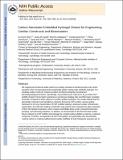Carbon-Nanotube-Embedded Hydrogel Sheets for Engineering Cardiac Constructs and Bioactuators
Author(s)
Shin, Su Ryon; Jung, Sung Mi; Zalabany, Momen; Kim, Keekyoung; Zorlutuna, Pinar; Kim, Sang bok; Nikkhah, Mehdi; Khabiry, Masoud; Azize, Mohamed; Kong, Jing; Wan, Kai-tak; Palacios, Tomas; Dokmeci, Mehmet; Bae, Hojae; Tang, Xiaowu (Shirley); Khademhosseini, Ali; ... Show more Show less
DownloadKong_Carbon-nanotube.pdf (3.268Mb)
OPEN_ACCESS_POLICY
Open Access Policy
Creative Commons Attribution-Noncommercial-Share Alike
Terms of use
Metadata
Show full item recordAbstract
We engineered functional cardiac patches by seeding neonatal rat cardiomyocytes onto carbon nanotube (CNT)-incorporated photo-cross-linkable gelatin methacrylate (GelMA) hydrogels. The resulting cardiac constructs showed excellent mechanical integrity and advanced electrophysiological functions. Specifically, myocardial tissues cultured on 50 μm thick CNT-GelMA showed 3 times higher spontaneous synchronous beating rates and 85% lower excitation threshold, compared to those cultured on pristine GelMA hydrogels. Our results indicate that the electrically conductive and nanofibrous networks formed by CNTs within a porous gelatin framework are the key characteristics of CNT-GelMA leading to improved cardiac cell adhesion, organization, and cell–cell coupling. Centimeter-scale patches were released from glass substrates to form 3D biohybrid actuators, which showed controllable linear cyclic contraction/extension, pumping, and swimming actuations. In addition, we demonstrate for the first time that cardiac tissues cultured on CNT-GelMA resist damage by a model cardiac inhibitor as well as a cytotoxic compound. Therefore, incorporation of CNTs into gelatin, and potentially other biomaterials, could be useful in creating multifunctional cardiac scaffolds for both therapeutic purposes and in vitro studies. These hybrid materials could also be used for neuron and other muscle cells to create tissue constructs with improved organization, electroactivity, and mechanical integrity.
Date issued
2013-03Department
Harvard University--MIT Division of Health Sciences and Technology; Massachusetts Institute of Technology. Research Laboratory of ElectronicsJournal
ACS Nano
Publisher
American Chemical Society
Citation
Shin, Su Ryon, Sung Mi Jung, Momen Zalabany, Keekyoung Kim, Pinar Zorlutuna, Sang bok Kim, Mehdi Nikkhah, et al. “Carbon-Nanotube-Embedded Hydrogel Sheets for Engineering Cardiac Constructs and Bioactuators.” ACS Nano 7, no. 3 (March 26, 2013): 2369–2380.
Version: Author's final manuscript
ISSN
1936-0851
1936-086X